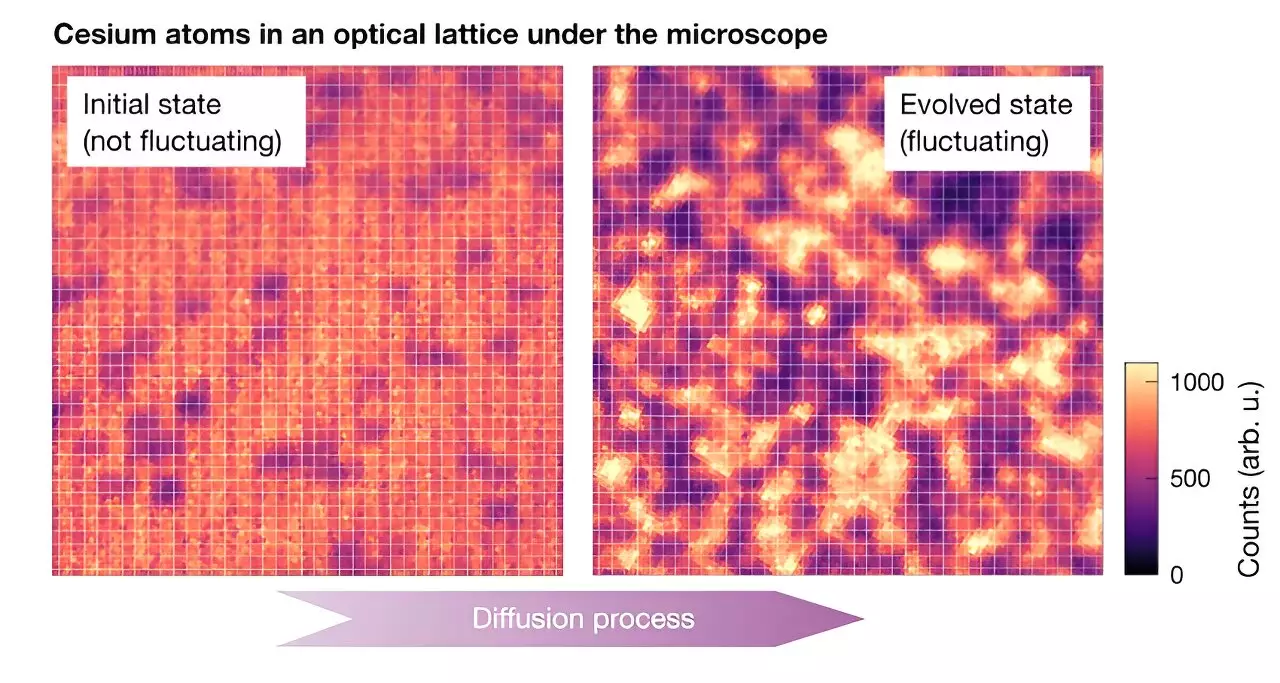Recent developments in quantum physics have pushed the boundaries of our understanding of complex quantum systems, illuminating the path for future explorations. A collaborative effort among researchers from the Ludwig-Maximilians-Universität, Max-Planck-Institut für Quantenoptik, Munich Center for Quantum Science and Technology (MCQST), and the University of Massachusetts has yielded promising results regarding equilibrium fluctuations within extensive quantum systems. Their findings, published in the prestigious journal Nature Physics, unveil a novel approach that applies fluctuating hydrodynamics (FHD) to chaotic quantum systems, providing a new perspective for future research endeavors.
Integral to the study was the employment of a quantum gas microscope, a sophisticated experimental tool that allows the manipulation and imaging of individual atoms within ultracold atomic gases. “Imagine having a multitude of particles in an enclosure and attempting to predict their future behavior,” remarked Julian Wienand, one of the study’s co-authors. The challenge arises when dealing with a significant number of particles, making traditional computational techniques insufficient due to resource limitations.
To mitigate this issue, researchers have turned to hydrodynamic theories that emphasize the collective behavior of particles rather than their individual tracks. By assuming a state of local thermal equilibrium under chaotic conditions, they can establish a macroscopic description of particle interactions by modeling them as a continuous density field subject to differential equations.
Fluctuating hydrodynamics extends the principles of classical hydrodynamics to account for thermal fluctuations that arise from the fast movement and interaction of particles. As these fluctuations exhibit randomness akin to white noise, they can be incorporated into existing differential equations to understand the dynamic behaviors of a system. Notably, FHD emphasizes that the evolution of such complex systems can depend on a limited set of parameters, notably the diffusion constant, a measure of how quickly particles spread within the medium.
The ability to apply FHD to quantum systems, notorious for their entangled and complex nature, offers an alternative framework for understanding phenomena that have long eluded classical theoretical approaches. By simulating quantum systems through this lens, insights into their dynamics are increasingly attainable, fostering improvements in predictability and comprehension.
The study conducted by Wienand’s team involved experiments focusing on cesium-133 (Cs) atoms within an optical lattice, a structure formed by laser beams that confines the atoms in a periodic arrangement. This setup allowed the researchers to create a controlled environment where they could manipulate the ultracold atoms and observe their interactions in significant detail. The quantum gas microscope’s capability to resolve single lattice sites proved crucial for assessing particle behavior and measuring fluctuations effectively.
The researchers excited the cesium atoms into a set configuration before reducing the lattice depth, which instigated movement and interaction among the particles. As these atoms began undergoing diffusion processes, the team meticulously tracked the growth of fluctuations over time, contributing towards validating the application of FHD and providing a quantitative measure of the diffusion constant in a chaotic quantum environment.
What emerged from this research was the remarkable realization that a chaotic quantum system, which may appear complicated at the microscopic level, could be represented via a classical diffusive model drawn from fluctuating hydrodynamics. This represents a substantial stride in bridging the gap between classical and quantum physics, suggesting that even intricate quantum behaviors could be simplistically interpreted through macroscopic properties like the diffusion constant.
Moreover, the findings pose intriguing questions regarding the nature of equilibrium within quantum systems. Even when a system appears out of equilibrium, FHD establishes connections that facilitate insights into its behavior. The researchers proposed that equilibrium properties, such as the diffusion constant, could indeed be gleaned from dynamic, out-of-equilibrium settings, further aligning classical theories with quantum phenomena.
As Wienand and his colleagues progress with their investigations, they plan to probe deeper into the dynamics underlying quantum many-body systems. This includes exploring how systems that do not thermalize behave concerning fluctuations and examining higher-order moments like skewness and kurtosis. By refining the FHD framework, it may be possible to tackle more complex observables and extend its application to exotic systems.
The implications of this research extend beyond mere academic curiosity; they resonate throughout various fields, including theoretical physics, materials science, and even quantum computing, as understanding chaotic quantum systems may provide the tools required for harnessing their potential in practical applications. The integration of fluctuating hydrodynamics into the study of quantum systems stands as a promising avenue for unlocking new paradigms in the ever-evolving landscape of quantum physics.


Leave a Reply